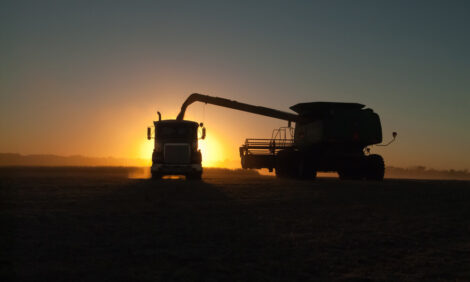



2012: US Crop Year-End Review
US - Despite the drought, the agricultural crop sector continues to record-breaking crop values, write Chad Hart, Lee Schulz and Kristen Schulte, all with Iowa State University Extension.Even though corn and soybean production fell dramatically in 2012, both corn and soybeans will set records in terms of the value of the crops due to the high prices being received. A decade ago, the corn crop was worth $20 billion. The 2012 corn crop is currently valued at over $80 billion.
In 2002, the national soybean crop had a production value of $15 billion. The current crop is valued at nearly $45 billion. So crop agriculture continues to produce significant economic value, even as the rest of the economy has struggled to grow.
The impact of the drought worked very quickly into the crop markets as prices this summer reached record levels. As the harvest rolled in, prices have softened a bit, but the markets are still offering very strong values. And the lack of production this year has the markets offering stronger prices for next year’s crops as well.

Many sectors of demand have backed off with the drought and the higher prices, but demand is still outpacing supply. Biofuels continue to be the leading source of crop demand. Exports have been supportive for soybeans. And livestock feed remains a critical part of the demand picture.
The supply picture for 2012 was drastically altered by the drought. As we started the year, there was the potential for record production as corn and soybean plantings were increased. Corn area increased by 5 million acres and soybean area increased by 2.2 million acres in 2012. But the drought sharply reduced yields and lowered production. Compared to last year, corn yields were down 17% nationally, 19% here in Iowa, and 38% in Illinois. For soybeans, national yields were down 10%, Iowa was down 17%, and Illinois fell 18%.
Given the supply shortfall, prices have risen and demand has weakened. Last year, ethanol passed domestic livestock feed as the #1 use of U.S. corn. Corn demand via ethanol topped the 5 billion mark for the 2011 crop. The outlook for the 2012 corn crop suggests ethanol usage of corn will fall in the current marketing year. As Figure 1 shows, the ethanol industry cut back on production this summer as the drought took hold.
Just as higher corn prices represent higher feed costs for livestock producers, they also represent higher feedstock costs for ethanol plants. With somewhat steady oil prices and higher corn prices, ethanol production margins were squeezed and the industry pulled back on production. A few ethanol plants shut down, while many others slowed down. Overall, the ethanol industry retreated 10% this summer and had not ramped back up this fall.
One of the bigger for the ethanol industry is that with gasoline consumption declining over the past few years, the potential market for ethanol has shrunk. And the industry has grown large enough to fill that potential market and provide some ethanol for the export market. Ethanol stocks now fluctuate between 750 and 950 million gallons. Those stocks keep ethanol prices fairly low and limit production margins. So the growth in corn demand via ethanol has stabilized, taking away the major growth factor in the market over the past five years.
Weekly Corn Use by Ethanol Plants

Corn feed and residual demand for the 2012 crop is projected at 4.15 billion bushels, as feed demand continues to shift lower. Returns to the livestock industry have retreated again as livestock prices could not keep pace with feed costs. Livestock production is in decline across the board as beef, pork, and poultry production is projected to lower in 2013. As was true last year, a big issue is price competition in feeds. Given corn’s relatively high price in comparison to other feeds, livestock feeders have moved to replace corn in part of the ration with lower cost feed.
Corn export demand is estimated at 1.15 billion bushels, down significantly from last year. The feed competition due to high corn prices is limiting corn exports. Figure 2 displays export sales so far this marketing year. All segments of the corn export market are lower this year. And the losses are significant. Sales to Japan and Mexico are down over 30%. Chinese purchases are down 50%. And exports to South Korea and Taiwan are off by more than 75%.
Corn Exports Through Late October (Source: USDA-FAS)

As like last year, exports remain the big story for soybeans, especially exports to China. While USDA has lowered its export estimate to 1.265 billion bushels, actual sales so far this year have higher than last year’s pace. The early sales data show strong demand from several countries. China leads the way, purchasing roughly 100 million bushels more thus far. But other countries such as Japan, Taiwan, and the European Union have also increased their soybean imports. As Figure 3 shows, current soybean exports are running nearly 40% above last year’s pace.
From their early October outlook, USDA had projected ending stocks for corn at 619 million bushels, over 250 million bushels less than last year. Soybean ending stocks were estimated at 130 million bushels, down 39 million bushels from last year. So U.S. ending stocks remain tight. Currently, USDA projects 2012/13 season-average prices at $7.80 for corn and $15.25 for soybeans. The futures markets have backed off from those levels though. Current futures prices point to 2012/13 season-average prices around $6.95 per bushel for corn and $14.37 per bushel for soybeans.
Soybean Exports Through Late October (Source: USDA-FAS)

With the sustained high prices for both crops, the acreage competition for 2013 should be interesting again. Corn again looks to have the upper hand in the competition. Futures indicate 2012/13 season-average prices in the $6 range for corn and $13 range for soybeans. But the biggest issue in the acreage decision may be soil moisture. Most of the country still remains under drought conditions. While some hurricane-induced rains have reduced soil moisture problems in the Eastern Corn Belt, the western Corn Belt continues to dry out.
Projections for 2013 Season-Average Prices Based on Futures










